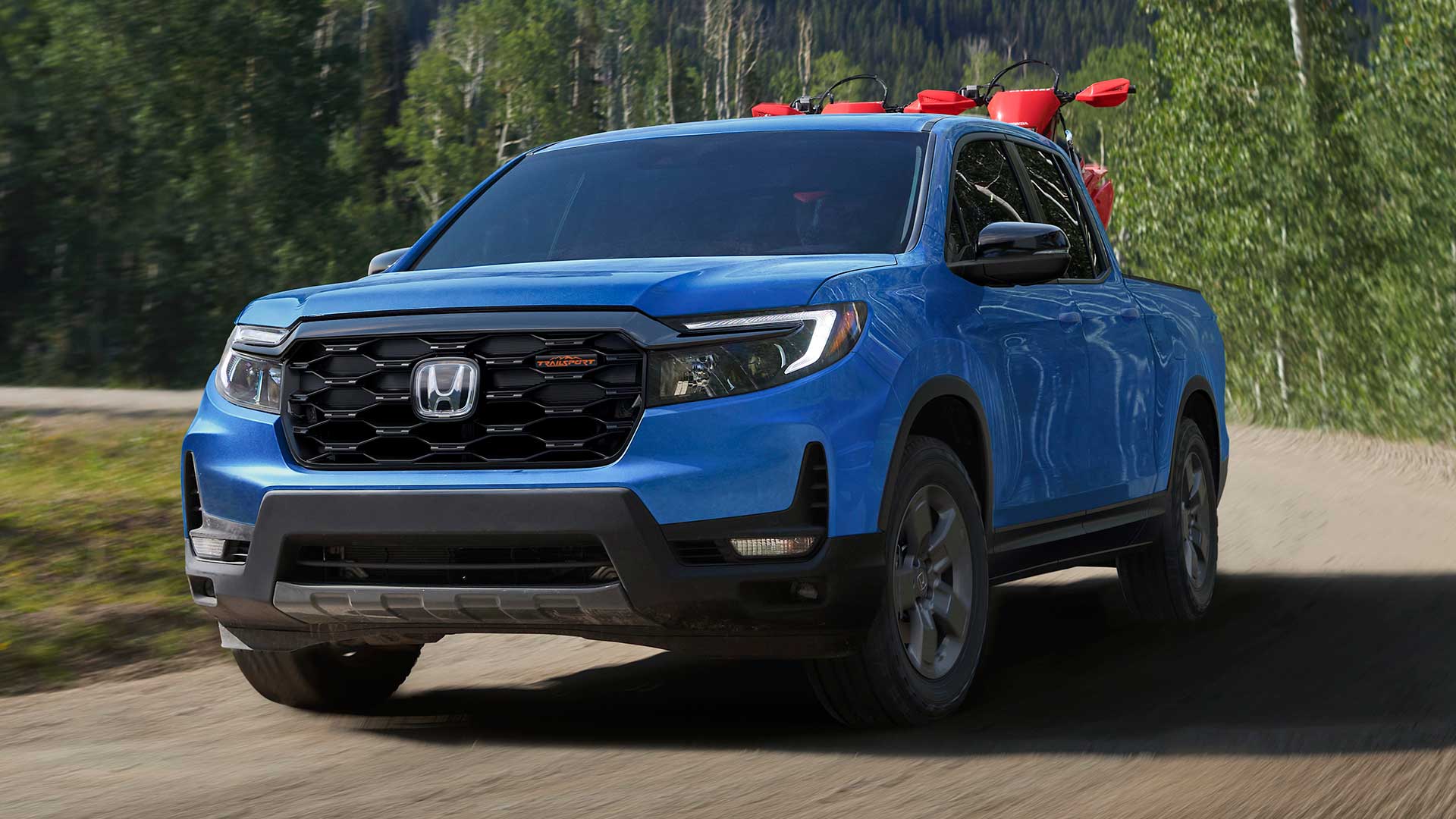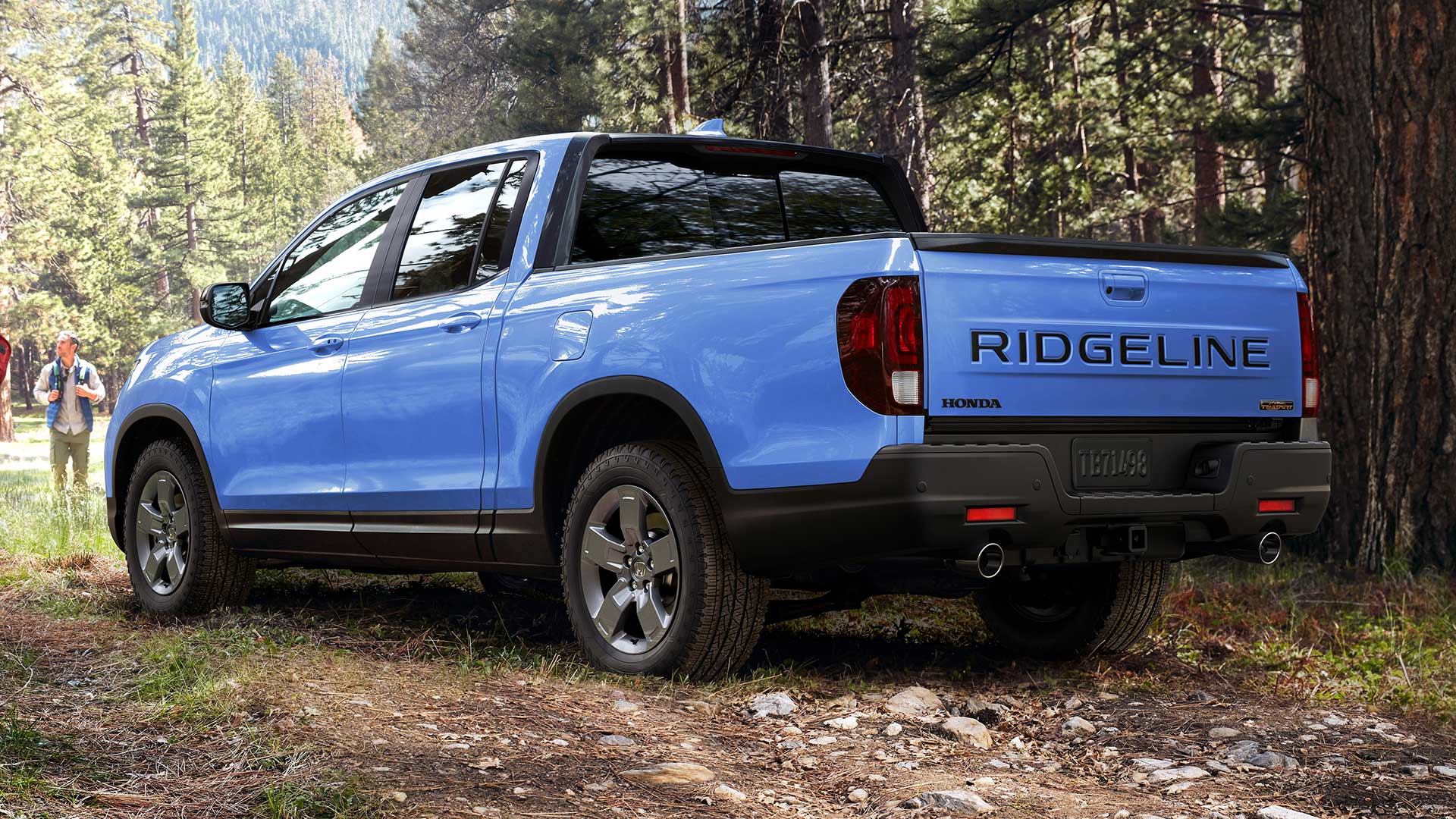2010 Audi A5 Cabriolet
Convertible season is here! And leave it to Audi to be ready with a new droptop, the A5 Cabriolet. Visually, it’s just as stunning as the coupe, but now for the real test. Let’s put on our Ray-Bans and head out on the highway. Cars don’t always make the transition from tin-top to convertible gracefully, but Audi has managed to keep their four-seat 2010 A5 Cabriolet beautifully proportioned.
Audi’s now familiar front end formula-big, rectangular LED-rimmed bi-Xenon headlights and a deep, drop jaw Nuvolari grille-is indistinguishable from the A5 hardtop. In profile, though, the power softtop makes for a longer, flatter trunklid. Whether you’re basking in the sun or keeping the rain at bay, the A5’s lines are pleasing from every angle.
Audi chose fabric over a metal droptop to save weight and bulk. It includes a glass rear window with defroster, and uses Audi’s new Acoustic Roof insulation to keep the cabin remarkably quiet. Top operation takes less than 20 seconds, even when driving up to 30 miles-per-gallon hour. Our tester’s burnt orange leather interior was trimmed tastefully in aluminum and wood. It proved comfortable for four adults, and as user-friendly as it was attractive.
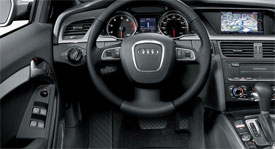 The dash caters to driver ergonomics. Gauges are clear and easy to read, and the thick-rimmed, multi-function, tilt-and-telescoping wheel is leather-wrapped. An array of airbags includes knee airbags for front-row occupants.
The dash caters to driver ergonomics. Gauges are clear and easy to read, and the thick-rimmed, multi-function, tilt-and-telescoping wheel is leather-wrapped. An array of airbags includes knee airbags for front-row occupants.
Audi’s Drive Select integrates operation of throttle, steering, and suspension, offering four distinct driver selected settings- Comfort, Auto, Dynamic, plus Individual. Feedback from Audi’s latest MMI hard-drive disc infotainment system is via the seven-inch screen mounted high in the center stack.
Our A5’s curvy, heavily-bolstered power front bucket seats featured neck-level heat vents. With the top up, there is of course sizable C-pillar blind spot. Luckily, our tester came equipped with Audi Side Assist, a useful blind-spot monitoring system in the side mirrors.
Thanks to the less bulky softtop, second-row occupants get a surprising amount of legroom, plus a wind diffuser, and rollover protection. Unusual for its class is a split folding rear seat that gives this Cabrio functional versatility. Filling all the seats still allows for a practical 10.2 cubic foot trunk, top up or top down. Most hardtop rivals have a fraction of that with the top down.
Like the Coupe, standard power is a direct-injected, turbocharged 2-liter I4. In the Cabrio it’s good for 211 horsepower and a stout 258 pound-feet of torque. For more power you’ll have to move up to the S5 Cabriolet with its supercharged 3.0-liter V6 rated at 333 horsepower and 325 pound-feet.
The 2.0, with standard front drive, transfers power through a CVT automatic. Our all-wheel drive Quattro uses a six-speed Tiptronic automatic with paddle shifters. There is no pure manual. With Quattro, this is a year-round convertible. Torque splits 40 percent front, 60 percent rear in routine driving.
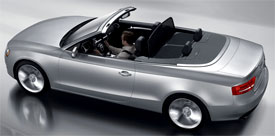 At the track, traction was in no short supply: zero to 60 took just 6.6 seconds. Turbo lag was almost non-existent, and shifts were well-spaced, if a little soft. The droptop A5’s relaxed demeanor didn’t hurt its quarter mile time: 15 seconds flat, at 90 miles-per-gallon hour.
At the track, traction was in no short supply: zero to 60 took just 6.6 seconds. Turbo lag was almost non-existent, and shifts were well-spaced, if a little soft. The droptop A5’s relaxed demeanor didn’t hurt its quarter mile time: 15 seconds flat, at 90 miles-per-gallon hour.
Through the low-speed slalom, the car’s heavily front-biased weight was apparent, but it still proved to be a nimble handler. Turn-ins were quick, and the car felt unusually solid for a convertible. We detected little cowl twist and shake. Body roll was present, but manageable.
Switchable ESP stability control, as well as ABS, are standard-issue. Four-wheel disc brakes stopped the A5 from 60 in a short average of 122 feet. Mild fade increased the distances slightly over six runs, and the pedal was soft, but stops remained smooth and straight.
Government Fuel Economy Ratings for our Quattro A5 Cabrio are 20 city, 26 highway. The front-drive droptop is rated at 23 city, 30 highway. On our test loop, the Quattro delivered an unsurprising 23.2 mpg on premium gas. Plus, with an Energy Impact Score of 14.9 yearly barrels of oil, and a Carbon Footprint of 8 tons of CO2, our A5 Cabriolet is relatively eco-friendly.
More so than prices, which start at $42,825 for the front-drive A5 Cabrio, and $44,925 for the all-wheel drive variant. But, go easy on options, the 60 grand mark is not hard to breach. Indeed, at that level it makes sense to upgrade to the S5 Cabriolet.
Still, even with the base 2010 Audi A5 Cabriolet, you’re getting a droptop that is easy on the eyes, with a sumptuous interior, and nearly impeccable road manners. Oh, and it will turn a few heads too. And, that test, like all the rest, this ragtop passes with ease.
Specifications
- Engine: Direct-injected, Turbocharged 2-Liter I4
- Horsepower: 211
- Torque: 258 Lb Feet
- 0-60 MPH: 6.6 Seconds
- 1/4 Mile: 15.0 Seconds @ 90 MPH
- 60-0 MPH: 122 Feet
- EPA: 20 MPG City/ 26 MPG Highway
- Mixed Loop: 23.2 MPG
- Energy Impact: 14.9 Barrels Oil/Yr
- CO2 Emissions: 8.0 Tons/Yr
2024 Honda Ridgeline TrailSport
It Does Truck-Like Things Better Than Ever
Honda brought something truly unique to the pickup truck scene when their mid-size Ridgeline debuted for 2006. In 2017, it moved towards becoming a little more true truck-like, both in form and capability, now with yet another step in that direction for 2024. So, let’s see if the Ridgeline is really hitting its stride.
For 2024, it’s all about making this Honda Ridgeline better than ever. There are styling tweaks outside, along with tech and functional improvements inside, but the biggest news is the Ridgeline has now joined Honda’s TrailSport family of off-road inspired vehicles. This more-true-trucklike, second-gen Ridgeline been around since 2017, receiving periodic updates over the years; but joining the TrailSport family is the biggest leap yet.
Primarily, the TrailSport transformation includes General Grabber all-terrain tires, mounted on new Pewter Gray 18-inch wheels, steel underbody protection, and retuning the strut front, and multi-link rear suspension for added wheel articulation. And while we always appreciate the additional traction of off-road tires, the Ridgeline’s standard i-VTM4 all-wheel drive, with Intelligent Traction Management and snow, sand, and mud settings, was already quite capable of handling all but the most extreme off-roading, ground clearance of just 7.6 inches being it’s only real hinderance.
A 3.5-liter V6 remains under the hood as it has since the Ridgeline debuted for 2006; the current version outputs 280 horsepower and 262 lb-ft of torque, plenty enough muscle to handle its 5,000-lbs. towing capacity. A nine-speed automatic transmission with paddle shifters and bevy of push and pull buttons on the console replaced the six-speed automatic back in 2020.
In addition to adding TrailSport capability, a big focus for this update was making it more user-friendly inside, starting with the central touchscreen growing from 8 to 9 inches. It also gets faster processing speeds, menus have been simplified, and the native navigation system is improved with better graphics. It’s accompanied by a new digital instrument cluster, along with an upgraded center console with more storage space. Unique TrailSport touches include heavy duty floormats, leather-trimmed seats, orange stitching throughout the cabin, and orange ambient lighting.
The Ridgeline continues to offer things available nowhere else in the pickup truck market.
Exterior styling doesn’t exactly shout “macho big rig coming your way,” but the more vertical face and larger grille that arrived for 2021, along with this year’s added TrailSport elements, do continue to toughen up the Ridgeline’s image. The 5’4” bed remains highly functional with no large wheel well intrusions, multiple tie-downs points, lighting and even speakers. And of course, the Ridgeline continues to offer things available nowhere else in the pickup truck market, like the dual-action tailgate, and large, lockable, drainable, underbed storage. Not to mention being able to drive around in true car-like comfort, something we took full advantage of on our way to our Mason Dixon Dragway test track.
There was great grip off the line, with full power arriving smoothly but quickly, helping us to get to 60 in 7.0 seconds flat, a tenth quicker than the last Ridgeline we tested. That power delivery stayed fairly consistent the whole way down the track, barely interrupted by the nine-speed automatic’s smooth shifting. Our best quarter-mile run was 15.5 seconds at 90 mph.
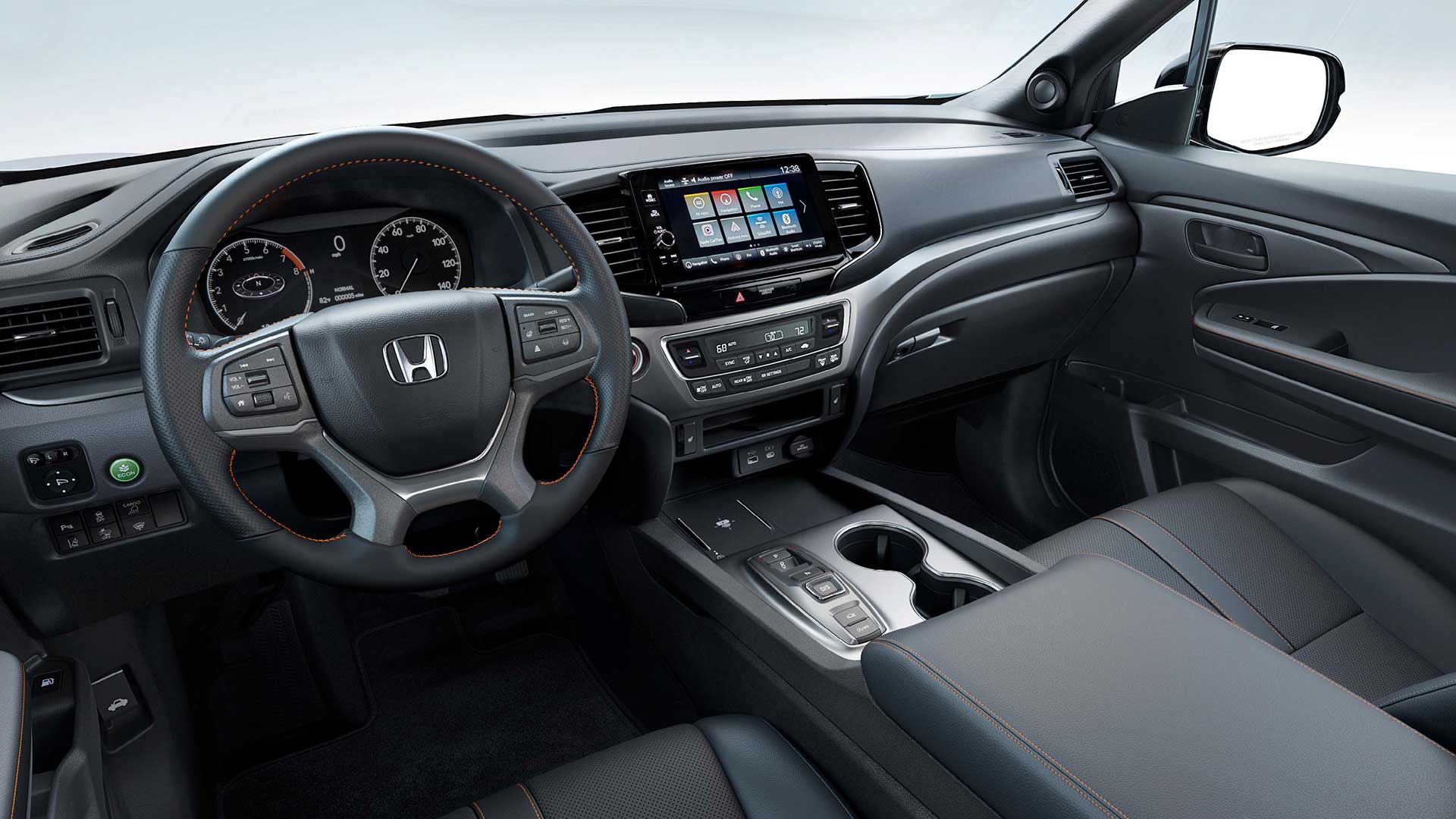
The revised suspension and knobbier tires didn’t really seem to add or detract from handling prowess, as it felt as solid, nimble, and car-like as it always has through our cone course. Perhaps a little less stiff than before, but good feedback, tight steering, and minimal body roll for a pickup, made for a very confidence inspiring experience. In our braking test, we stopped in a respectable average of 123 feet from 60, with only moderate amounts of nosedive and good feel through the pedal.
There is, however, a slight reduction in Government Fuel Economy Ratings with the all-terrain tires; 18-City, 23-Highway, and 20-Combined, our average, right on, at 20.4 mpg of Regular. That’s a slightly below average Energy Impact Score of 14.9 barrels of yearly oil use, with CO2 emissions of 7.4 tons.
TrailSport pricing falls in line just under the Ridgeline’s top Black Edition trim with a starting price of $46,375, about five grand over a base Ridgeline Sport.
So, whether you consider the Honda Ridgeline to be a “real” truck or not, this ruggedly smooth 2024 TrailSport does truck-like things better than ever. And we’re not just talking about the slight upgrade in off-road performance, we’re talking about a flexible bed to help you get chores done, and the ability to tow or haul with comfort and flexibility other trucks can only wish for. It’s why the Ridgeline brings more first-time buyers to Honda than any other vehicle, and why it continues to be a great choice in the growing midsize truck realm.
Specifications
- Engine: 3.5-liter V6
- Transmission: 9-speed automatic
- Horsepower: 280
- Torque: 262 lb-ft
- EPA: 18 City | 23 Highway | 20 Combined
- 0-60 mph: 7.0 seconds
- 1/4 Mile: 15.5 seconds at 90 mph
- 60-0 Braking (avg): 123 feet
- MW Fuel Economy: 20.4 mpg (Regular)
- Max Towing Capacity: 5,000-lbs








